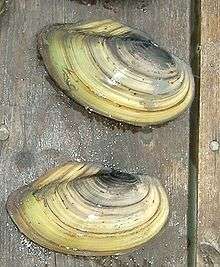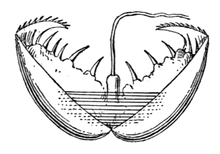Swan mussel
The swan mussel, Anodonta cygnea, is a large species of freshwater mussel, an aquatic bivalve mollusc in the family Unionidae, the river mussels.
| Swan mussel | |
|---|---|
 | |
| Scientific classification | |
| Kingdom: | Animalia |
| Phylum: | Mollusca |
| Class: | Bivalvia |
| Order: | Unionida |
| Family: | Unionidae |
| Genus: | Anodonta |
| Species: | A. cygnea |
| Binomial name | |
| Anodonta cygnea | |
Because of its morphological variability and its wide range of distribution, there are over 500 synonyms for this species.[2]
Shell description
The shell is thin but large (approximately 10 to 20 cm) and rather flat, even at the umbo. The shell color is often pale greenish or brownish. It differs from Anodonta anatina in being larger shell with straighter, more parallel dorsal and ventral margins; the growth lines of the inner, oldest part of the shell are finer and shallower, and reach the margin.[3]
Distribution
Its native distribution is European-Siberian. The geographical distribution of this species is from the British Isles east to Siberia, and south into northern Africa.
- Croatia
- Czech Republic – in Bohemia, in Moravia,[4] vulnerable (VU);[5] Czech code, Decree for implementation, No. 395/1992 Sb. (and No. 175/2006 Sb.) – highly threatened species
- Germany– highly endangered (stark gefährdet);[6] listed as a specially protected species in annex 1 in Bundesartenschutzverordnung
- The Netherlands[7]
- Poland – endangered[8]
- Slovakia
- Sweden – quite rare[9]
- British Isles including Ireland
- Italy
- Portugal
- Denmark
Habitat

This species is found in rivers and lakes. They have a strong pungent odor and are used by carp fisherman as bait.
References
- Lopes-Lima, M. (2014). "Anodonta cygnea". IUCN Red List of Threatened Species. 2014: e.T156066A21400900. doi:10.2305/IUCN.UK.2014-1.RLTS.T156066A21400900.en.
- "Certain Mussel Species Have been Over-Named". The MUSSEL Project. 28 December 2007. Archived from the original on 19 October 2012. Retrieved 23 April 2018.
- "Species summary for Anodonta cygnea". AnimalBase. Retrieved 23 April 2018.
- M., Horsák; L., Juřičková; L., Beran; T., Čejka; L., Dvořák (2010). "Komentovaný seznam měkkýšů zjištěných ve volné přírodě České a Slovenské republiky" [Annotated list of mollusc species recorded outdoors in the Czech and Slovak Republics] (PDF). Malacologica Bohemoslovaca (in Czech). Suppl. 1, 1–37.
- "Red List of the molluscs (Mollusca) of the Czech Republic". Institute of Zoology, Slovak Academy of Sciences. 30 May 2010. Retrieved 23 April 2018.
- Glöer, P.; Meier-Brook, C. (2003). Süsswassermollusken (in German). Deutscher Jugendbund für Naturbeobachtung. pp. 134, 109. ISBN 3-923376-02-2.
- "Flora en Fauna soorteninformatie" (in Dutch). Stichting ANEMOON. Retrieved 23 April 2018.
- Zając, Katarzyna. "Anodonta cygnea (Linnaeus, 1758)". Polska Czerwona Księga Zwierząt – Bezkręgowce. Archived from the original on 27 December 2016. Retrieved 23 April 2018.
- "Swan mussel". The Swedish Museum of Natural History. 30 September 2009. Archived from the original on 14 February 2012. Retrieved 23 April 2018.
External links
| Wikimedia Commons has media related to Anodonta cygnea. |
